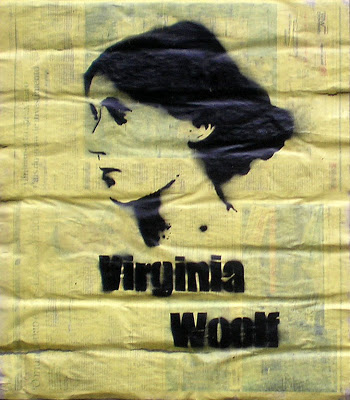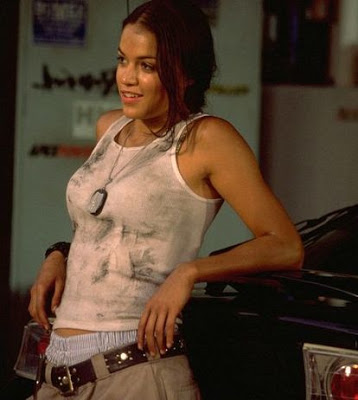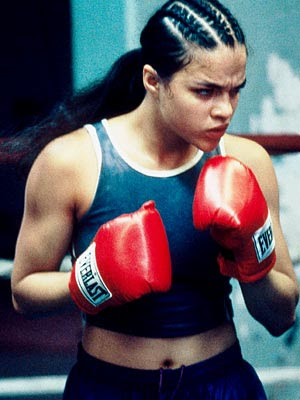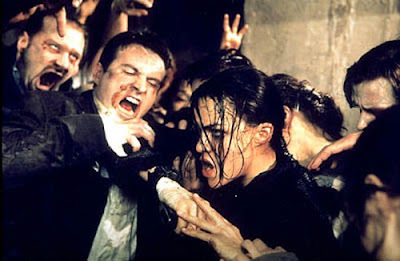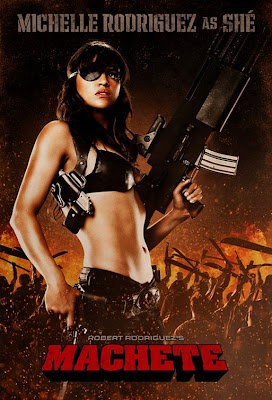This is a guest post by Jessamyn Neuhaus.
SPOILER ALERT: This post contains big spoilers if you have not seen the films Divergent, The Maze Runner, and The Giver. If you have not read the Hunger Games novels, it contains a major spoiler for Mockingjay Part 2.

Almost 100 years after first-wave feminists secured American women the right to vote, there is still a massive gender gap when it comes to political power in the United States. Consider our new 2015 Congress: a whopping 80 percent of our elected leaders in D.C. are men (oh, and 80 percent white and 92 percent Christian). That paltry 20 percent is ginormous compared to female American CEOs and top executives—5 percent at last count. Then there’s my personal favorite, the enduring tendency among college students to automatically give their male professors better evaluations than female professors. When it comes to wielding real political, economic, and cultural authority over other people, many Americans still seem to assume that the person in charge should also wield a penis.
Popular culture reinforces, and challenges, the notion that if a woman achieves a leadership position, there must be something suspect, something unfeminine, about her. TV and movies remain chockablock with depressingly conventional depictions of women in power: bitchy and/or oversexed bosses, ball-busting iron maidens, and professionally-successful-but-personally-a-mess singletons. However, at the same time, women are also far more equally represented alongside men in cinematic offices of power than in real life. Catch any random Law and Order episode and you will see successful and influential female attorneys, detectives, police officers, judges, politicians, doctors, and business professionals in action. Heck, on TV women are not only Secretary of State, but also Vice President and even POTUS. I, for one, would immigrate immediately to any nation where Alfre Woodard is giving the executive orders.

Of all the genres that could envisage a world of more complete gender equality, science fiction seems like our best bet. After all, life has got to be better a few hundred years from now, right? Not according to American entertainment, where the future is always dystopian, not utopian. In our movies, TV, and fiction, the world to come is inevitably a hellish urban wilderness or a post-apocalyptic badland plagued by vampires, viruses, aliens, malevolent robots, or ecological disasters.
YA dystopian fiction in particular is having its moment right now. Last year saw the release of at least four dystopian films based on young adult fiction containing some pretty dire visions of future societies. All four featured an almost identical female leader character. She’s coldly calculating, middle aged, icily beautiful, and a villainess—or, at the very least, a highly misguided leader whose blind devotion to a rigidly depersonalized or somehow “perfected” world forms the basis of the conflict with the main characters. In Divergent, Kate Winslet plays Jeanine Matthews, Erudite faction leader; Ava Paige is the head scientist of W.I.C.K.E.D. and played by Patricia Clarkson in The Maze Runner; Meryl Streep plays the Chief Elder in The Giver; and President Alma Coin is played by Julian Moore in The Hunger Games: Mockingjay Part 1 and Part 2 (coming in 2015).
Now, on the one hand, you gotta admire a movie employing any one of these talented actors. Even though they are all A-listers, because they are over 34 years old these four women will earn less and be offered fewer parts in Hollywood than their male counterparts. Also, there’s something to be said for simply seeing a powerful female character in a leadership role. As Amanda Rodriguez writes in a Bitch Flicks post about Julian Moore’s character in Mockingjay Part 1, “this embodiment of a nontraditional representation of matriarchy in Coin is refreshing. She is decisive, smart, calm when under attack, and always thinking about the greater good of the people.”

But on the other hand, there’s a troubling trend here, because four movies in one year definitely counts as a trend. All of these future worlds are shaped and influenced by beautiful but heartless middle aged women who rule over a dehumanized dystopia with an immaculate but totally iron fist. In Mockingjay Part 1, Julian Moore’s President Coin is leading the rebellion and although she’s ruthless, she’s one of the good guys. But WARNING! BIG SPOILER HERE in the final chapters of the novel Mockingjay we learn that in her own grab for unlimited power, Coin callously facilitated the death of Prim, Katniss’s beloved sister, and blamed it on the Capitol. Presumably, Part 2 will include this big reveal, and Coin will then join the ranks of dystopian female fanatical leaders depicted in The Giver, The Maze Runner, and Divergent.
Meryl Streep’s Chief Elder character in The Giver is not as overtly evil, but her insistence on the rigid eradication of human individuality and free will to maintain peace and order in “the community” is definitely creepy and makes her the very bad guy in charge. In one pivotal scene, we learn that the policies Chief Elder enforces are so mercilessly conformist that even a young infant who fails to live up to certain standards of behavior will be dispassionately dispatched down a bad baby chute to oblivion.

Patricia Clarkson’s Ava Paige in Maze Runner is a hazy figure in the main characters’ flashbacks, until LAST WARNING, I MEAN IT, SPOILER AHEAD a scrappy band of teenagers escapes the maze and discovers that Paige is the head scientist/leader of the sinister scientific organization that imprisoned them in the maze in the first place. Paige claims that she did it in order to test a possible cure-all for the disease/ecological apocalypse threatening human existence. For a minute it seems that Paige is the ruthless but brilliant scientist who stops at nothing to save the world, even shooting herself at the end of her video message in the ultimate sacrifice to the cause. But no. She appears in one last scene, calmly wiping the fake blood off her face and announcing the commencement of…Phase Two. Bwahahahaha!
The Divergent villainess played by Kate Winslet is similarly cavalier with human lives, orchestrating a takeover by the relentlessly logical Erudite faction that begins with a planned mass extermination of all men, women, and children in the peace-loving Abnegation faction. Because, um, nothing’s more bloodcurdling than an intimidating perimenopausal woman in a chic suit who values brains more than abnegation? So it seems. Rodriguez writes in her Bitch Flicks post reviewing Divergent: “I’m frankly so tired of the cold, fanatic female villain trope.” (She also points out that this trope is not unique to YA-based dystopias, citing Jodie Foster’s 2013 turn as Delacourt in Elysium.) Rodriguez rightly asks of Divergent: “Is it claiming that cold, intelligent women are the problem? Are they the purveyors of this dysfunctional culture? If so, for which real world social ill is the post-apocalyptic world of Divergent a stand-in? What problematic mechanism of power does this sci-fi series seek to illuminate?”
Unfortunately, I don’t think these four “cold, intelligent women” are illuminating “problematic mechanisms of power” at all. Rather, they are expressions of the persistent distrust of female authority in our current culture. These characters serve as a type of sexist shorthand for a society gone terribly, terribly wrong. Though not necessarily the sole “purveyors of this dysfunctional culture,” their pitiless rule symbolizes just how bad it’s gotten, because when women hold the kind of power and authority that renders them coldblooded killers, there’s something awfully amiss. But it’s essential to note that we’re talking here only about the power and authority of older, non-motherly, women. In these films, it’s perfectly all right, nay, imminently laudable, for women to kick ass and flex their muscles and be all empowered—as long as they are teenagers. If your boobs are still high and firm and your skin youthful and dewy, why, there’s nothing more attractive than leading the rebellion or fighting your way to freedom.
Snark aside, two of the youthful female protagonists in these films are pretty great. Calling attention to some of the problematic aspects of these films certainly doesn’t erase the positive features. Katniss is one of the most interesting female pop culture characters in recent years and is played by an extremely talented young woman who has chosen a range of nuanced roles—all hail Jennifer Lawrence! Shailene Woodley’s protagonist in Divergent is not bad either, casting off her namby-pamby Abnegation name “Beatrice” for gender-bending “Tris”; doggedly training at bare knuckle fighting; and eventually bringing a mad conspiracy to its knees (kinda with the strength of her devoted love for the young hero, but it’s YA, so they get a pass there). Even the tiresome helpmeet-to-the-hunky-hero female teenage characters in The Giver and Maze Runner are relatively strong and capable and not particularly cringe-inducing (though in her Bitch Flicks post Megan Kearns accurately points out that The Maze Runner exemplifies the Smurfette Principle).
So what’s with those other female characters, the Ice Queens of the future? If the teenage women can be heroes, why do the militant extremists running these four YA dystopias have to be older women? The novelists who created these characters and the filmmakers who brought them to the screen are demonstrating that despite the many gains we’ve made toward gender equality, we’re still stuck with rigidly defined ideals of femininity for women over 40—and those ideals do not include attaining professional positions of power. That old favorite, the Madonna/whore dichotomy, takes a contemporary dystopian twist here. The older female characters embody a mom/megalomaniacal dictator dichotomy, in which the acceptable roles for middle aged women appear to be limited to either the mother of the protagonist or deranged antagonist, drunk with power and out for world domination.
In my book Housework and Housewives in American Advertising I discuss how the “new momism” (identified by Susan J. Douglas and Meredith W. Michaels in The Mommy Myth) shapes contemporary gender norms and advertising, and I wrote about it in another Bitch Flicks post. Although Americans have long idealized motherhood, the new momism of our era is the basis for a freshly insidious ideology that subtly but persistently demarcates parenting as women’s (unpaid) work—in fact, women’s best and only really valuable work. The villains of these four dystopias are the antithesis of good mothers. They are a direct and active threat to the teenage protagonists. And, it’s very clearly implied, what could possibly be more disconcerting? More dystopian? These disturbing versions of future dehumanized societies suggest that a middle aged female head of state is particularly chilling.
Interestingly, the mothers of the main characters do appear in The Giver and Divergent and throughout the Hunger Games. In The Giver, Katie Holmes plays the mother character, who’s an emotionless adherent to the dehumanizing rules that govern “the community.” Paula Malcomson as Katniss’ mother in The Hunger Games is not such a stooge of the regime, and joins the rebellion in the capacity of a healer, but when the trilogy begins, she’s willing to comply with the requirements of the Hunger Games and offer her daughter for possible sacrifice. She has virtually no impact on Katniss’ life by the end of Mockingjay—she’s just a minor character.
Ashley Judd’s mother character, Natalie, plays a bigger role in the plot of Divergent. The piously humble Abnegation paragon Natalie reveals at a crucial point that she is divergent like her daughter and possesses all the fighting ability and fearlessness of the Dauntless faction. But Natalie exercises this power in a completely mom-appropriate way. Natalie only reveals her abilities in order to save daughter Tris from certain death at the hands of the Erudites. Then Natalie sacrifices her own life in a gun battle to keep Tris safe. She’s the total and complete opposite of Jeanine Matthews. The casting and wardrobe is instructive as well, with baby-faced Judd as the mom in sackcloth serving as a dramatic contrast to chilly blonde razor-edged power suited Winslet as the anti-mom.

It’s no coincidence that the laws of these four dystopias, which are led by four really scary bitches, trash the most sacred of familial bonds. Quite literally, in the case of the baby chute in The Giver. These worlds feature dehumanizing regulations, brutal power regimes that keep the masses broken and victimized, and/or rigid emotionless policies that heartlessly separate mother and child. They conform to the most exaggerated stereotypes of what will happen when women who don’t know that their real place is in the home caring for their children start prowling the halls of power. What happens when women take charge? What happens when moms can’t be moms? Or, worse yet, choose not to be? Just the end of the world, that’s all.
Obviously, the scenario of mom-aged women not being good moms holds particular significance for a YA audience. I’m no Freudian but as a college teacher, the mother of a fourteen year old son, and a former teenager myself, I can attest to the fact that many adolescents and young adults experience a mostly unconscious fear of/highly conscious burning desire to be on their own and to do it without parental interference. It’s a pretty standard stage of emotional development, and the source of a great deal of conflict between parents and their teenagers. Not that I’ve been reading any parenting advice books about this or anything.
To some extent, this may help explain the almost identical villainesses in Divergent, The Maze Runner, The Giver, and Mockingjay. In the YA dystopian landscape, the cruel mom-aged woman in charge adds to the terror and thrill of fighting your way to freedom. In Divergent, the teen protagonist Tris defeats Kate Winslet’s Matthews in hand to hand combat, finally defeating Matthews with—oh irony!—the same mind-control drug Matthews used to enslave the Dauntless faction to do her evil bidding. In Katniss’s case, the betrayal of Julianne Moore’s President Coin is the final push Katniss needs to instigate the climax of the Hunger Games series. To truly free her people, Katniss must defeat this cold surrogate of a mother figure. Meryl Streep’s Chief Elder in The Giver, a softer villain, is moved to tears by the new knowledge she gains of human connection. Her crying clearly shows her evolution toward a more appropriately female emotional responses. Meanwhile, we have to wait and see what’s to become of Patricia Clarkson’s Wicked Witch of W.I.C.K.E.D. until the next installment in The Maze Runner franchise.
But although the defeat of the powerful anti-mother may appeal in some developmental, metaphorical way to many teenage consumers, it is also clearly infused with broader social and cultural fears about women in power. These characters markedly reinforce our wider unconscious and consciously accepted assumptions about who should be in charge in politics, in business, in the college classroom, and just about everywhere else. To solely see these dystopian villainesses as archetypes in the psychosomatic journey to adulthood doesn’t take into account the specific time and place and culture that produced them and the very real ways gender bias shapes actual power distribution in today’s United States. A fictional world depicting a powerful female leader as an unfeminine antifamily power-hungry bitch looks way too much like our real world, where powerful female leaders are often depicted as…you know.
I’m not saying the bad guys in dystopian fictions should always be, well, guys. Nor am I arguing that all evil female fictional characters should be subject to rigorous feminist deconstruction. Sometimes a villainess is just a villainess. But I do want to suggest that we have a problem when the bad guys in four widely read and viewed YA dystopias are, across the board and uniformly, supposed to be especially frightening because they so blatantly contradict what women of a certain age should be. They reiterate and reinforce the notion that nothing could be more dystopian than a mother-aged woman who doesn’t act motherly. Fear of the future? No, the same old fear that still shapes how Americans vote and learn and hire and live: fear of a woman in charge and in power.
Jessamyn Neuhaus is a professor U.S. history and popular culture at SUNY Plattsburgh. She is the author of Housework and Housewives in American Advertising: Married to the Mop (Palgrave Macmillan, 2011).


